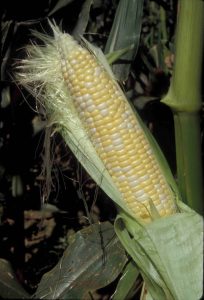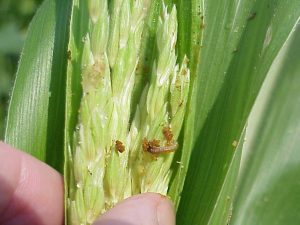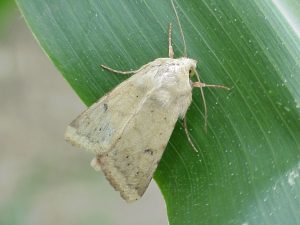Sweet Corn IPM Newsletter No. 4 – July 14, 2017
 Sweet Corn IPM Newsletter No. 4 – July 14, 2017
Sweet Corn IPM Newsletter No. 4 – July 14, 2017
Click on photos to enlarge.
Highmoor Farm Field Day
Wednesday, July 26, 2017
Save the date!
FALL ARMYWORM ACTIVE IN CORN FIELDS
Corn Earworm Spreading Throughout State
SITUATION
More fields are coming into silk this week and growth is looking good overall. Unfortunately, corn earworm numbers are increasing and fall armyworm has made its first appearance, threatening silking fields. Remember that applying sprays at the early tassel stage can provide good control of European corn borer and fall armyworm as they move from the whorl or tassel to the ears.
European corn borer: Moth captures continue to be scattered and relatively low, but larval feeding activity was found in nearly all the fields we scouted. More fields were over the recommended spray thresholds with 15% of pre-tassel plants showing injury. Fields in Biddeford, Cape Elizabeth, Dayton, Nobleboro, Poland Spring, Sabattus and Wells were over threshold for pre-tassel corn so sprays were recommended. In silking corn, sprays may also be based on the number of moths caught in pheromone traps to prevent larvae from infesting the ears, but no fields were over the 5-moth threshold this week.
- European Corn Borer Larvae on Pre-tassel Stage Corn; photo by David Handley
- Corn Earworm Moth; photo by David Handley
Corn earworm: Moths have been more widely distributed and in higher numbers this week, but not all locations had captures or were over threshold for silking corn. Growers with early corn should be on the alert to protect any silking fields if moths are found in the area. A 6-day spray interval for corn earworm was recommended for silking fields in North Berwick and Wales this week. A 5-day spray interval was recommended for silking fields in Cape Elizabeth and Nobleboro. When no silking corn is available, corn earworm larvae may chew large, ragged holes in the leaves, similar to fall armyworm. This should be counted in field scouting for European corn borer and fall armyworm.
Fall armyworm: The first confirmed fall armyworm moths were captured in our pheromone traps this week, and feeding damage was found in several fields. When feeding damage is found in a field, it is counted and combined with any European corn borer damage found. If the total injury exceeds 15% in corn at pre-tassel or beyond, a spray is recommended. Once the corn has reached the silking stage, sprays may be based on captures of moths in pheromone traps. This prevents larvae from getting into the silk channel and damaging ears without leaving visible injury for field scouting. If three or more moths are caught in a week in silking fields, a spray is recommended, unless the field is currently under a spray interval for corn earworm. Sprays for corn earworm should provide control of fall armyworm.
- Male Fall Armyworm Moth; photo by David Handley
- Male (left) and Female (right) Spotted Wing Drosophila; photo by Griffin Dill. Actual size: 2-3 mm.
Spotted wing drosophila: Flies have been in several Maine berry fields over the past week. Growers with ripening blueberries or raspberries should be on the alert for flies or larvae in the fruit. For details, visit our Spotted Wing Drosophila blog.
Squash vine borer moths were caught in pheromone traps in Wells, Biddeford, Cape Elizabeth, Nobleboro, Farmington, Oxford and New Gloucester this week. The Biddeford, Cape Elizabeth, New Gloucester and Oxford sites were above the 5 moths per week spray threshold, and a spray was recommended. This pest is active in much of the state. Growers with squash and pumpkins should be on the lookout for vine borer symptoms and protect squash plants if moths or damage are seen.

HOLD THE DATES:
Fruit and Vegetable Growers Field Day at Highmoor Farm: Wednesday July 26, 2017 from 8:30 a.m. to 3:00 p.m. Visit the Highmoor Farm website for more information. Please register by July 17! Call 207.933.2100 for additional registration information.
New England Vegetable & Fruit Conference is scheduled for December 12-14, 2017 in Manchester, NH. Please visit the website. Details and registration information coming soon.
Sincerely,
David T. Handley
Vegetable and Small Fruit Specialist
Highmoor Farm, P.O. Box 179, 52 US Route 202, Monmouth, ME 04259, 207.933.2100
UMaine Extension Diagnostic Research Lab, Pest Management Unit, 17 Godfrey Drive, Orono, ME 04473, 1.800.287.0279
| Location | CEW Moths |
ECB Moths |
FAW Moths |
%Feeding Damage |
Recommendations / Comments |
|---|---|---|---|---|---|
| Auburn | 0 | 2 | 0 | 6% | No spray recommended |
| Biddeford | 0 | 0 | 2 | 23% | One spray recommended for ECB |
| Bowdoinham | 1 | 1 | 0 | 11% | No spray recommended |
| Cape Elizabeth I | 2 | 2 | 0 | 10% | No spray recommended (no silking corn) |
| Cape Elizabeth II | 6 | 0 | 2 | 23% | 5-day spray interval recommended on all silking corn |
| Dayton I | 1 | 0 | 0 | 22% | One spray recommended for ECB |
| Dayton II | 1 | 0 | 0 | 1% | No spray recommended |
| Farmington | 0 | 1 | 0 | 3% | No spray recommended |
| Lewiston | 0 | 0 | 6 | 0% | One spray recommended for FAW on all silking corn |
| New Gloucester | 0 | 0 | 0 | 3% | No spray recommended |
| Nobleboro | 5 | 2 | 6 | 27% | 5-day spray interval recommended on all silking corn |
| North Berwick | 3 | 0 | 0 | 5% | 6-day spray interval recommended on all silking corn |
| Oxford | 1 | 0 | 2 | 1% | No spray recommended |
| Poland Spring | 1 | 0 | 0 | 52% | One spray recommended for ECB +FAW |
| Sabattus | 1 | 0 | 0 | 32% | One spray recommended for ECB |
| Wales | 3 | 0 | 0 | 0% | 6-day spray interval recommended on all silking corn |
| Wayne | 1 | 0 | 0 | 10% | No spray recommended |
| Wells I | 0 | 0 | 0 | 21% | One spray recommended for ECB on pre-tassel corn |
| Wells II | 1 | 1 | 0 | 0% | No spray recommended |
CEW: Corn earworm (Only fresh silking corn should be sprayed for this insect.)
ECB: European corn borer
FAW: Fall armyworm
| Moths caught per week | Moths caught per night | Spray interval |
|---|---|---|
| 0.0 to 1.4 | 0.0 to 0.2 | No spray |
| 1.5 to 3.5 | 0.3 to 0.5 | Spray every 6 days |
| 3.6 to 7.0 | 0.6 to 1.0 | Spray every 5 days |
| 7.1 to 91 | 1.1 to 13.0 | Spray every 4 days |
| More than 91 | More than 13 | Spray every 3 days |
Thresholds apply only to corn with exposed fresh silk. Lengthen spray intervals by one day if maximum daily temperature is less than 80°F.
European Corn Borer Thresholds
Whorl stage: 30% or more of plants scouted show injury.
Pre-tassel-silk: 15% or more of plants scouted show injury.
Silk: 5 or more moths caught in pheromone traps in one week.
IPM Web Pages:
UMaine Cooperative Extension Integrated Pest Management
Penn State Pest Watch for Sweet Corn
UMass Amherst Integrated Pest Management
Where brand names or company names are used, it is for the reader’s information. No endorsement is implied nor is any discrimination intended against other products with similar ingredients. Always consult product labels for rates, application instructions and safety precautions. Users of these products assume all associated risks.
The University of Maine is an equal opportunity/affirmative action institution.




